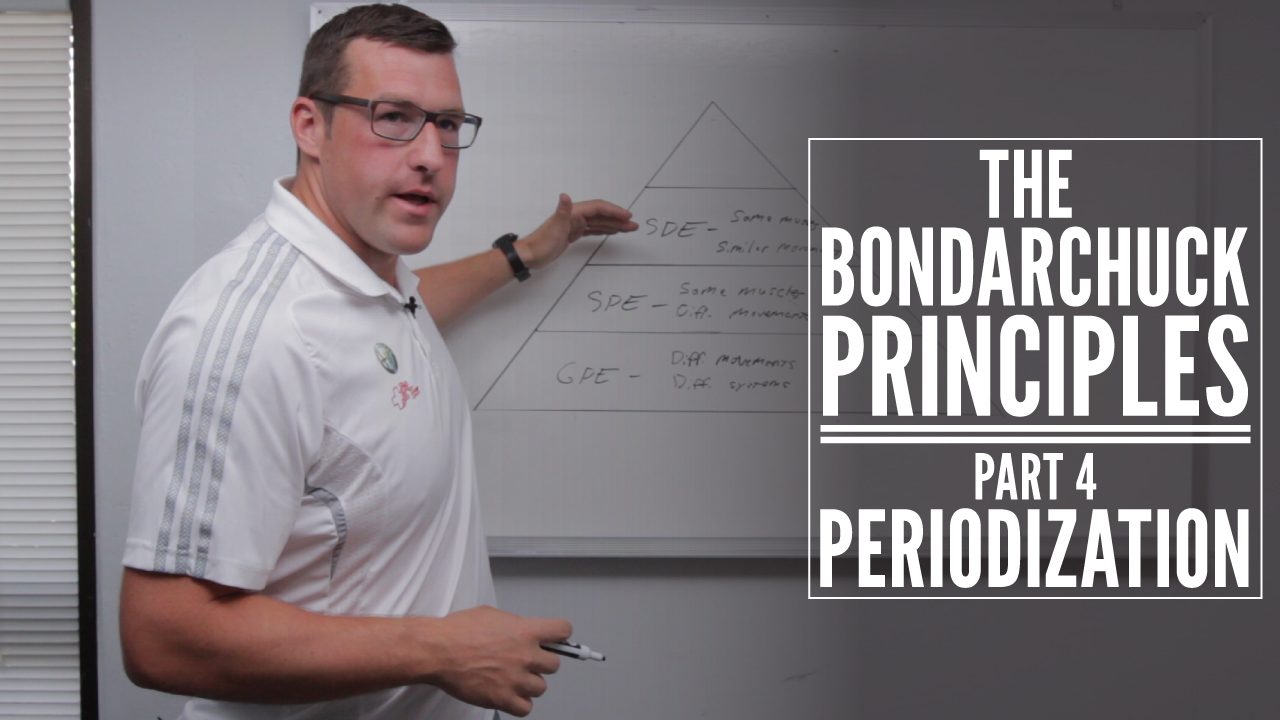Periodization is the complex process of developing a training plan designed to increase performance. This week, special guest Martin Bingisser is back in the final episode on his training series to share his thoughts on the periodization model of the legendary Bondarchuk.
Intro To Bondarchuk Periodization
In this week’s episode of 8 WeeksOut TV, we’re wrapping up our series with Martin Bingisser by talking about programming with Bondarchuk’s principles of periodization.
So we’re going to discuss how to put Bondarchuk’s exercise classification system to work…
To give you a little perspective, let’s first take a look at what makes Bondarchuk’s system of organization so different from the average North American coach:
In the hammer throw, specifically, what Bondarchuk is doing differently is often working at lower intensities and higher volumes throughout the week. Most of the training time is going to be devoted to two exercise classifications:
1.) competitive exercises
2.) specific developmental exercises
In contrast, you’ll find most North American coaches devoting more time to general strength development: specific preparatory exercises and general preparatory exercises. Bondarchuk is focused on more event-specific exercises.
Given the attention that high intensity training has received in North American sports, it’s important to note the stark contrast in Bondarchuk’s approach: not every training session needs to be high intensity. In fact, you’ll find that most of Bondarchuk’s exercises are low intensity. Yet his approach obviously works.
Within the weight room, Bondarchuk’s athletes are typically working in the 60-80% intensity range. The intensity isn’t extremely high, but these workouts are being performed every day or twice a day.
You might see faster results if you do high intensity training over the course of a month, but if you have long term goals, low intensity work will serve you better. You have to look at the bigger picture.
Bondarchuk’s Programming Concepts
Let’s put together all of the pieces of Bondarchuk’s methodology we’ve gone over into an actual training program.
At the end of a day, selecting an exercise is great, but you have to be able to put it together into a plan in order to achieve the results you want. This is where Bondarchuk’s concept of periodization comes in.
First, remember that Bondarchuk periodizes things differently for different athletes and for different sports.
There are over 2 dozen training concepts he’s put together, from block periodization to complex periodization (which we’ll use here). Just bear in mind that what we’re discussing is just the tip of the Bondarchuk iceberg, so to speak.
For a broader picture, we’ll start with an overview of traditional block periodization:
In the first cycle, you start out working on your general preparatory exercises only. In the second cycle, you work on specific preparatory exercises only. So in each block, you’re focusing on only one category of exercises. You progress from more general to more specific exercises.
You can see the shortcomings of this kind of periodization for sports such as MMA or for the hammer throw:
You can’t afford to spend two training blocks away from your actual event. You’ll lose your technique.
So one of the simpler planning concepts used for the hammer throw is called complex periodization: work on all 4 exercise categories at once.
This means that within one training session, a hammer-thrower will be performing throws, special development exercises, squats & cleans, and coordination/warm-up exercises.
Changes Between Complex Periods
You’ll make some changes as you go from one period to the next, but you will still be working all 4 exercise categories with each period. So you might change the weight of the throw from heavier to lighter or the type of exercise from squats to step-ups. You need to keep introducing changes so that you continue to adapt.
You’ll typically be doing 10 total exercises and 7 or 8 of those will change with the next period.
Key point: you are doing the same exercises day-in and day-out during each period. This constant daily stimulus will help your body adapt better and faster.
There is hardly any variation in sets and reps over the course of a week.
Even though the repetitiveness of the training exercises seems simple, it’s critical that you evaluate your athletes to choose exercises that click well with them. This doesn’t eliminate the need for athlete feedback from training.
This type of periodization is especially good for beginners, because it’s difficult to tell what part of the program is working if you vary too many elements. Complex periodization makes it simpler to identify which exercises work for which athletes.
A period typically lasts between 4-8 weeks for most athletes Bondarchuk works with, but this is highly individual.
Athlete-Dependent Changes in Periodization
You measure each athletes results every day throughout the period and each athlete typically falls within 3 categories:
1.) Gradual growth in results
2.) Initial dip in results followed by gradual growth
3.) Initial plateau in results, followed by a dip, then gradual growth
You can tell when it’s time to change an athlete’s program based off of which of these 3 types of results the athlete experiences.
When you start to see personal records and peaks, it’s time to change the program. Your body has adapted to the stimuli of the current period and needs new stimuli to improve.
Once you’ve discovered which of the 3 types of athletes you’re working with, it’s relatively easy to predict when they will peak; the time to peak will generally remain the same from period-to-period.
This allows you to plan for your athletes to peak at the appropriate times.
Summing Up Bondarchuck Periodization
To sum up what we’ve just talked about, this is a useful system of categorizing what you’re doing into how close you are to a competitive event; the closer you are to your event, the greater the portion of your training time spent in specific, competitive exercises (such as sparring for MMA) will be.
Exercise selection is also critical. You don’t have to choose 100 different exercises. The higher you move up the pyramid of specificity, the fewer exercises you have to choose from. A large portion of your training time will be spent performing relatively few exercises.
If you’re interested in more of Martin’s methodology and training principles, visit his webisite. You can also follow him on Facebook and Twitter.
For more information on Bondarchuk’s principles, Bondarchuk has published books on the transfer of training and books on periodization:
Transfer of Training in Sports
Transfer of Training in Sports Volume II
Periodization of Training in Sports Volumes 1-4
About Martin Bingisser
 Martin Bingisser is a tax attorney, track and field coach, and five-time Swiss national champion in the hammer throw. He has been training with Dr. Anatoliy Bondarchuk since 2005 and writes frequently about Bondarchuk and other training topics on his blog
Martin Bingisser is a tax attorney, track and field coach, and five-time Swiss national champion in the hammer throw. He has been training with Dr. Anatoliy Bondarchuk since 2005 and writes frequently about Bondarchuk and other training topics on his blog


Trackbacks/Pingbacks